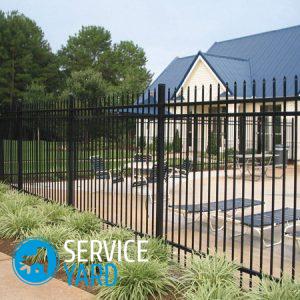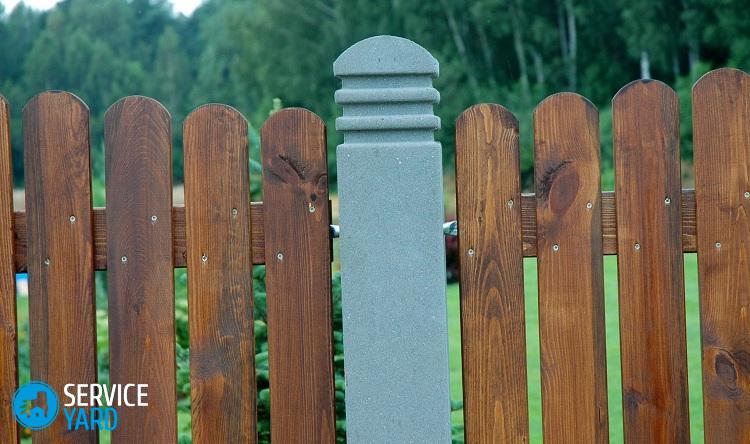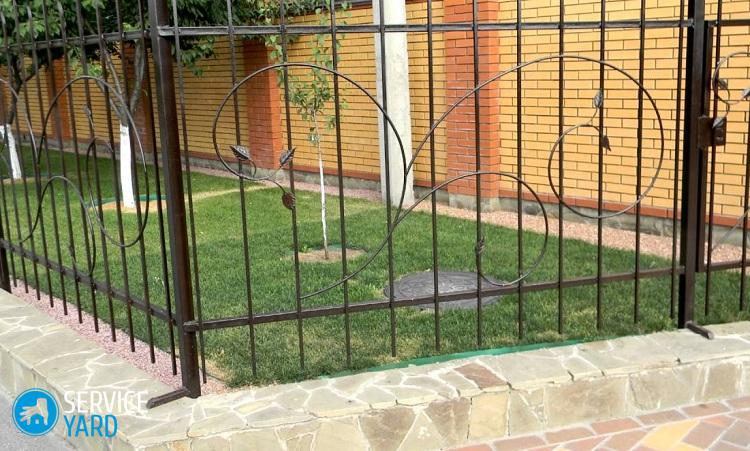Installation of fence posts

Supports, which are used for the construction of fences on country estates or cottages, can be made of wood, metal, brick, concrete and plastic. Installing poles for the fence is a simple matter and even not too skilled at home craftsman can do it. However, the implementation of this work requires strict consistency and adherence to technology. Only in this case will everything be performed perfectly. All norms and rules will be discussed in this article.
to contents ↑Appointment
A fence is a long-term construction designed for years. The more carefully it is made, the longer its service life. Therefore, the construction of the fence should be treated with no less responsibility than the construction of other outbuildings on the site.
Most of the fences include such structural elements:
- Foundation.
- Supports.
- Sectional filling.
Important! If you are thinking about how to install fence posts, you need to understand what exactly they take on the lion's share of the entire load, provide the fence with the necessary strength, rigidity and reliability. Careful and competent execution of work will allow to do without repair of the structure for decades.
The quality factors of pile installation are influenced by such factors:
- The depth of the pits under the pillars.
- The way to fix the piles.
It is these characteristics that determine the degree of reliability of the fence.
to contents ↑Common mistakes
Often the installation of posts for the fence with their own hands is accompanied by such flaws:
- Mistakes made in choosing the foundation.
- Incorrectly executed foundation.
- Incorrectly installed posts. Unfortunately, many people think that it’s quite easy to bury them in the ground.
to contents ↑Important! If mistakes are made at the stage of construction of the foundation, then the supports are already collapsing after 3-5 years.
Classification
Since there are many varieties of fences, the selection of material for the supports must be approached responsibly.
The most common options are.
- Concrete These supports are purchased ready-made or made of concrete mix on their own. The manufacturing process of such products is quite lengthy.
Important! The main advantages of concrete are its relatively low cost and long service life.
- Wooden. For wood pillars, the working life does not exceed one decade. Before installing the posts for the fence with their own hands, they are impregnated with an antiseptic solution and then stained annually.
- Metal. These are strong and reliable designs. The metal pipes that go into the manufacture of supports are closed with plugs on top so that moisture does not penetrate inside.
- Asbestos-cement. Pipes from this material are not subject to decay and are characterized by increased strength. The disadvantage of this option is that it is quite difficult to mount them, additional devices, such as clamps or grips when installing the lag, are needed.
- Brick. Such a support is not only reliable and durable, but very beautiful. Brick retains its performance properties after decades of service. However, due to the significant weight, a fairly strong foundation will be required for brick pillars. Dressing with dressing is also required.
to contents ↑Important! If you do not follow the technology of masonry, the fence will quickly lose its attractive appearance.
Ways to install fence posts
When installing poles for the fence, it is necessary to take into account the variety of soil:
- For non-porous soils, the concreting method is best suited. A pillar is inserted into the prepared hole, leveled according to the building level, and then poured with concrete mixture.
- If the soil is heaving, then this method is not suitable, because over time, the soil simply pushes a column out of the hole, and the fence is deformed. For heaving soils, supports are installed in a pit, which is dug lower than the level of soil freezing. The support in this case is buried almost half in the ground and a lot of mortar is consumed. The design is reliable, but you cannot call it economical.
- A universal method of installation is the placement of poles in holes with a larger diameter than the supports. The remaining space is laid with chipped bricks and rubble. This creates good drainage for the structure.
Installation of concrete fence posts
The main advantages of the concrete structure:
- Durability, reliability.
- Resistance to decay and corrosion.
- No need for care.
- Resistance to mechanical damage and weather conditions.
Important! Independent production of concrete supports requires considerable labor costs, the availability of free space for drying, concrete mortar and special forms.
Molds for concrete supports are made of such materials:
- Metal.
- Polyurethane.
- Fiberglass.
The solution is poured into a mold and kept until it solidifies. Before pouring concrete mortar, the mold is lubricated with a special composition. Bound fittings are placed throughout the mold. Inserts are also installed, which serve as fixtures for the sections. The inserts are placed in the upper and lower parts of the support at equal intervals from the edge. The solution in the form is poured in 1 stage.
Installation of wooden fence posts
The advantage of wooden supports for fences - in their efficiency. However, they do not differ in durability and require special regular care. But this option, in addition to profitability, has the following advantages:
- Environmental Safety.
- With good care - strength.
- Good combination with wood paneling.
Important! The best option for timber for fence supports is pine, larch or oak. It is necessary that the columns are well-dried and devoid of bark. On a good beam there are no bundles, knots and molds.
Deformation of the beam indicates that it was improperly dried. If the bark remains on the column, then insects can settle in it.
Before installation, the pillar is treated with an antiseptic and a special impregnation-flame retardant that prevents fire. The installation procedure is as follows:
- The columns at the bottom (about ⅓) are fired and smeared with resin.
- Installation begins with marking the territory. Places for holes under supports are marked at a given interval.
- Using a drill, they make meter holes in which the posts are installed. The pillars themselves are secured with concrete or rubble.
Metal pipe
The installation of metal poles for the fence is advisable if the fence itself is made of a mesh netting or corrugated board. It is best to use metal pipes with brackets welded to them. Concrete supports are well combined with a concrete fence.
Features of work:
- Before installing the supports in pre-drilled holes, the lower part of the pipes is treated with an anticorrosive composition.
- At first, angular supports are mounted.
- Fine gravel is poured into the wells to a height of 150 mm.
- Correct installation is determined by the building level.
- After the pillars are installed, the wells are concreted.
Asbestos cement
Asbestos-cement pipes are used if the fence itself is not very heavy. Installation is carried out in the following order:
- In marked areas, holes are drilled with expansion in the lower part.
- A tube of roofing material is installed in each of the wells so that each of them protrudes about 200 mm above the surface.
- Build plank formwork for concrete.
- Concrete is poured into the pit recess.
- They fill the well with concrete (not completely!), Install reinforcement in it. The length of the reinforcing rods is slightly less than the finished supports.
- Holes are made in pipes made of asbestos cement, a king pin from a reinforcing bar is inserted into them.
- Put the pipes on the reinforcement cage. In this case, the pin rests against the formwork so that the pipe is suspended.
- Pillars are leveled and fixed.
- The well is filled with concrete to the top of the formwork.
- The design is left until the solution solidifies for several days.
- After the concrete has hardened, the king pin is removed, and the pipes are filled with concrete mixture to the full length.
Brick
Brick fences look solid and reliable. The cost of this design is quite significant. The construction of brick supports with their own hands requires certain skills and experience.
Important! It is necessary that all applied building materials be of high quality. As a rule, the thickness of the support column is 1.5-2 bricks.
Construction Algorithm:
- Mark the plot and scale drawing. Marking is done with wooden stakes, taking into account the type of soil and the size of the site. The interval between adjacent pillars is 2.5-5.0 m.
- The foundation under the supports is created extended downward. A correctly executed foundation pit has the shape of a truncated pentahedron. At the same time, the foundation does not deform even with significant soil shifts.
- The depth of the foundation is approximately 200 mm greater than the freezing level. A thick-walled pipe is installed in the center of the pit, which gives the structure additional rigidity. The top of the pipe is covered with a cap or poured with concrete.
- For a lightweight construction, a strip foundation for spans and supports is sufficient. The arrangement of waterproofing is mandatory.
- After the concrete has hardened, the formation of masonry begins. Bandaging with reinforcement of brick construction is required.
- Pillars withstand up to 2 weeks. The brick is covered with a special protective composition so that it retains an attractive appearance for a longer time.
Stock footage
Pillars can be purchased ready-made or made by yourself. An unprofessional master can also perform this work, if he takes into account all the technical requirements for certain materials. In this case, the fence will turn out not only beautiful, but also durable.
- How to choose a vacuum cleaner taking into account the characteristics of the house and coatings?
- What to look for when choosing a water delivery
- How to quickly create comfort at home - tips for housewives
- How to choose the perfect TV - useful tips
- What to look for when choosing blinds
- What should be running shoes?
- What useful things can you buy in a hardware store
- Iphone 11 pro max review
- Than iPhone is better than Android smartphones





